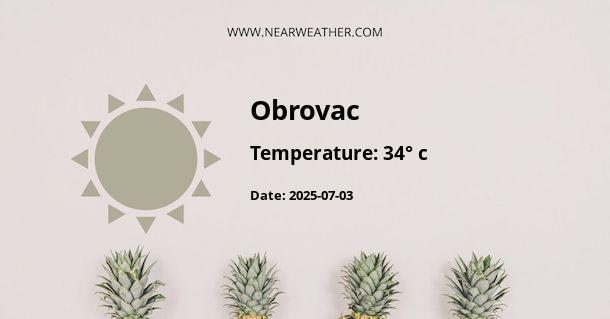Obrovac, Croatia: An In-Depth Look at Climate and Year-Round Weather Patterns
Located in the rugged landscape of Croatia's Dalmatia region, the town of Obrovac sits at the gateway to the enchanting Velebit mountain range and the azure waters of the Novigrad Sea. This strategic position significantly influences its climate, lending to a weather pattern uniquely tailored by both the Mediterranean and the continental climate systems. Understanding this duality is essential for visitors, residents, and businesses alike, as it dictates everything from tourism to agriculture in the area.
Geographical Influences on Obrovac’s Climate
Obrovac's climate is primarily Mediterranean, characterized by hot, dry summers and mild, wet winters. However, due to its proximity to the Velebit mountain range, the region also experiences a modified continental climate, especially in areas further inland. The Velebit mountains form a natural barrier that affects weather patterns, causing a phenomenon known as the 'bora' wind, a dry and often strong northeasterly wind that can significantly impact the local weather conditions.
Temperature Trends Throughout the Year
In Obrovac, summer temperatures can soar, providing a perfect environment for beachgoers and those looking to explore the natural beauty of the region. July and August present the peak of summer warmth, with average high temperatures ranging from 30°C to 35°C (86°F to 95°F).
- June to August (summer): Hot, sunny days with limited precipitation.
- September to November (fall): Transition from warm to cooler temperatures, with increasing rainfall.
- December to February (winter): Cooler temperatures and significant rainfall, mild compared to continental regions.
- March to May (spring): Gradual warming with varied precipitation patterns.
Temperature Overview Table
| Season | Average High | Average Low |
|---|---|---|
| Summer | 30°C - 35°C | 20°C - 24°C |
| Fall | 18°C - 25°C | 11°C - 17°C |
| Winter | 7°C - 13°C | 2°C - 6°C |
| Spring | 15°C - 22°C | 7°C - 13°C |
Precipitation Patterns and Phenomena
Rainfall is an essential part of Obrovac's climatic personality. Winters can see a hefty amount of precipitation, contributing to lush plant life and contributing to the area's renowned water systems, including the Zrmanja River which is known for its stunning canyon and beautiful waterfalls. Fall and winter months tend to be the wettest, with rainfall tapering off significantly as summer nears.
- Northwesterly winds (Maestral) are common in summer, offering much-needed relief from the heat.
- The 'bora' wind, a powerful and cold down-slope wind, is a significant feature in winter.
- The 'jugo' or 'sirocco', a southeasterly wind, can bring humid and warmer air, often accompanying rain.
Precipitation Overview Table
| Month | Average Rainfall |
|---|---|
| January | 89 mm |
| February | 77 mm |
| March | 78 mm |
| April | 76 mm |
| May | 72 mm |
| June | 61 mm |
| July | 42 mm |
| August | 57 mm |
| September | 80 mm |
| October | 97 mm |
| November | 137 mm |
| December | 120 mm |
Seasonal Activities and Recommendations for Visitors
Obrovac offers a diverse range of activities influenced by its climate and weather. In the summer, outdoor activities such as hiking in the Paklenica National Park, rafting on the Zrmanja River, and enjoying the beaches of the Novigrad Sea dominate the agenda. Visitors are advised to bring light, breathable clothing, sun protection, and to stay hydrated to cope with the high temperatures.
During the cooler months, exploring cultural sites like the historic Obrovac Castle or participating in local festivals can provide insight into the rich heritage of the region. Appropriate clothing includes layers that can adapt to varying temperatures and precipitation levels common during these seasons. The bora wind also necessitates wind-resistant attire for those venturing outdoors.
Average Sunshine Hours and Sea Temperature
| Month | Average Sunshine Hours | Sea Temperature |
|---|---|---|
| January | 4 | 13°C |
| February | 5 | 13°C |
| March | 6 | 14°C |
| April | 7 | 15°C |
| May | 9 | 18°C |
| June | 10 | 22°C |
| July | 11 | 24°C |
| August | 10 | 25°C |
| September | 8 | 23°C |
| October | 6 | 20°C |
| November | 4 | 17°C |
| December | 3 | 15°C |
Climate Change and Future Considerations
As global climate patterns shift, Obrovac, like many places worldwide, could face changes in its traditional weather patterns. An increase in the frequency of heatwaves, changes in precipitation timing and volume, and more extreme weather events are possible outcomes. Planning for these changes involves incorporating resilience into infrastructure, preserving natural resources, and adapting tourism activities to ensure the continued prosperity and sustainability of this breathtaking Croatian gem.
"The climate of Obrovac, with its Mediterranean allure and continental touches, intertwines the best of both worlds. Visitors and residents alike are treated to a diverse environment where each season brings its own palette of weather, dictating the rhythm of life and activities in this historic and ecologically vibrant region." - Local Climatologist
In conclusion, Obrovac's climate is a complex tapestry woven from Mediterranean sunshine, alpine influences, and the oscillation of seasonal winds. By understanding its climate and weather patterns, one can truly appreciate and prepare for the bounty and challenges inherent in this Croatian locale. Whether you're enjoying the peak of summer or wandering through the quieter, wetter winters, Obrovac's climate is an essential part of the town's character and charm.
A - Obrovac's Latitude is 44.200562 & Longitude is 15.682220.
A - Weather in Obrovac is 15° today.
A - Climate Conditions in Obrovac shows overcast clouds today.
A - Humidity in Obrovac is 97% today.
A - Wind speed in Obrovac is 12.46 km/h, flowing at 145° wind direction. today.
